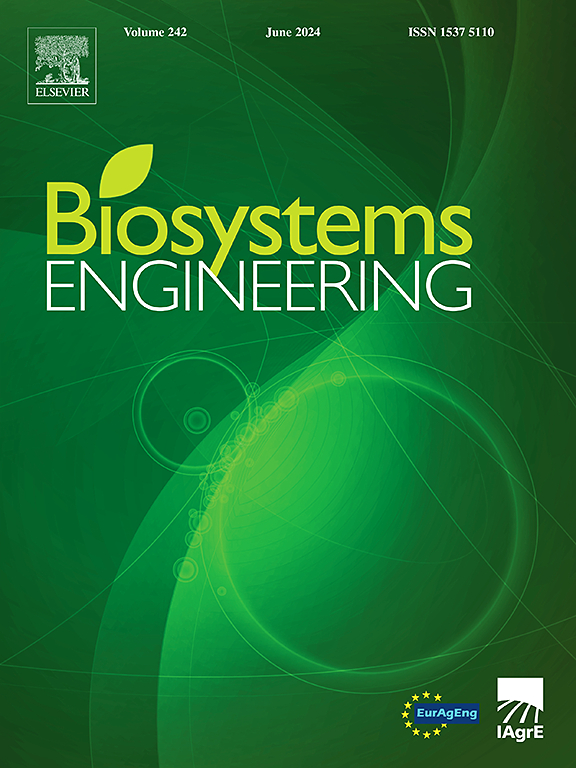Early detection of bacterial canker in tomato plants using spectroscopy for smart agriculture applications
IF 4.4
1区 农林科学
Q1 AGRICULTURAL ENGINEERING
引用次数: 0
Abstract
Clavibacter michiganensis subsp. michiganensis (Cmm) causes bacterial canker in tomatoes, causing severe yield loss. It would be of practical research interest within smart agriculture to develop an effective and quick method to distinguish pre-symptomatic infected tomato plants from healthy ones to take protective measures in time. In this study, artificially inoculated tomato plants with Cmm were grown in a temperature-controlled chamber. Using the Relief method, 25 wavelengths in the visible spectrum (cyan and red regions) showed the highest statistical differences, between healthy and asymptomatic infected tomato plants, two days before the first appearance of the foliar symptoms, in each plant. In addition, inoculated tomato plantlets showed differences in contrast to healthy ones, in the near-infrared spectrum, thirteen days after the inoculation with Cmm. The spectral data were used for the creation of early detection models of healthy and inoculated pre-symptomatic plants, in a specific number of days before the appearance of the first symptoms, in each plant, and in a specific number of days-post inoculation, using two ML algorithms (SVMs and kNN). The algorithms proved effective and robust in the discrimination of the two classes of the two instances mentioned. Furthermore, three patterns of data-preprocessing followed before the training of the algorithms, i.e. the case of multidimensionality, the application of PCA, and the use of Relief method. Finally, six models were created for datasets that contain spectral data of asymptomatic inoculated with Cmm and healthy tomato transplants, all of which showed very high overall accuracy, ranging from 92 to 100%.
在智能农业应用中利用光谱技术早期检测番茄植物中的细菌溃疡病
密歇根锁杆菌亚种。密歇根菌(Cmm)引起番茄细菌性溃疡病,造成严重的产量损失。开发一种有效、快速的方法来区分病前番茄植株和健康番茄植株,及时采取防护措施,对智能农业具有重要的现实意义。在本研究中,用Cmm人工接种番茄植株在温控室中生长。使用Relief方法,在每株植物首次出现叶面症状前两天,在健康和无症状感染的番茄植株之间,可见光谱中的25个波长(青色和红色区域)显示出最高的统计差异。此外,接种Cmm后第13天,接种番茄植株的近红外光谱也与健康番茄有差异。利用两种ML算法(支持向量机和kNN),将光谱数据用于建立健康植株和接种植株的症状前早期检测模型,在每个植株出现第一个症状前的特定天数,以及接种后的特定天数。结果表明,该算法对上述两个实例的两类识别是有效的和鲁棒的。此外,在算法训练之前,有三种数据预处理模式,即多维情况下的数据预处理、PCA的应用和Relief方法的使用。最后,在包含无症状接种Cmm和健康番茄移栽光谱数据的数据集上建立了6个模型,所有模型都显示出非常高的总体准确率,范围在92%到100%之间。
本文章由计算机程序翻译,如有差异,请以英文原文为准。
求助全文
约1分钟内获得全文
求助全文
来源期刊

Biosystems Engineering
农林科学-农业工程
CiteScore
10.60
自引率
7.80%
发文量
239
审稿时长
53 days
期刊介绍:
Biosystems Engineering publishes research in engineering and the physical sciences that represent advances in understanding or modelling of the performance of biological systems for sustainable developments in land use and the environment, agriculture and amenity, bioproduction processes and the food chain. The subject matter of the journal reflects the wide range and interdisciplinary nature of research in engineering for biological systems.
 求助内容:
求助内容: 应助结果提醒方式:
应助结果提醒方式:


